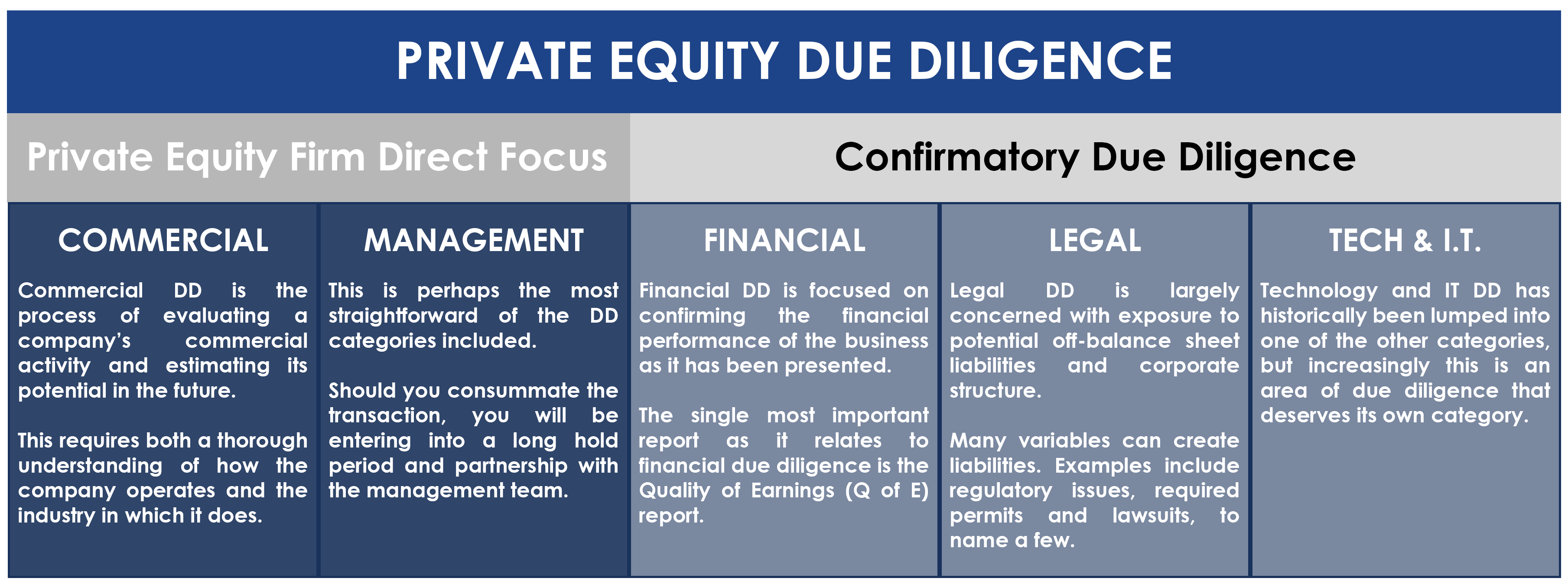Summary Text
Once a transaction has been secured under letter of intent, the due diligence effort ramps aggressively. As mentioned in the Letter of Intent course, the exclusivity period is a limited window, and the amount of work required to complete a due diligence effort is substantial. To help delineate the effort, the due diligence process will be broken down into the five primary focus areas visible in the image below.
It is not uncommon to see private equity due diligence defined by three of the five categories. Historically it has been taught as a practice divided between commercial, financial and legal due diligence. But you will not find a single investor that will downplay the role of management in an operating business, and while information technology (IT) may have been viewed largely as a support function previously, it is increasingly viewed as a driver of growth and value within an organization.
Author’s Note: When I first started working in M&A, IT due diligence was frequently grouped under financial due diligence because IT infrastructure supported financial reporting. From the time I transitioned to private equity in 2009, I rarely saw a due diligence process that did not require a separate third party to perform IT due diligence.
At a more macro level, private equity due diligence should also be divided between confirmatory due diligence and exploratory due diligence. Most exploratory due diligence is focused on commercial and management due diligence, which per the image is where the private equity firm will be most directly involved. At this stage, the investment team is exploring the opportunity as though the information provided is accurate. The objective is to develop the confidence to move forward before engaging third parties to confirm the assumptions supporting the team’s investment thesis.
Confirmatory due diligence is expensive. It involves validating the assumptions supporting the investment thesis, and generally requires engaging third-party specialists. While three of the categories above are exclusively labeled “confirmatory due diligence,” it is possible that all five categories will involve some amount of confirmatory due diligence. With respect to commercial due diligence, and by way of example, a private equity firm can hire a third party to perform industry analysis or to perform a customer survey. Some private equity firms, especially those with a strong industry focus may not find this necessary because they have this expertise in house. As it relates to management due diligence, however, in any process it would be irresponsible not to engage a third party to run background checks on the management team.
Author’s Note: It has been my experience that most management teams do not lie about their background, but in my opinion this step should never be overlooked. Background checks are a relatively inexpensive part of the process, and any detail that might expose if a key employee is (or has been) dishonest is worth the trouble. As the number of fraud cases revealed each year suggest, if someone wants to fool you, they probably can.
The Excel workbook available for download contains a list of third-party reports and an estimate of the cost associated with engaging the related third parties. Transaction expenses associated with documenting and closing a transaction can easily range between $250,000 and $750,000. Ideally an investment opportunity would be explored in a way that allows the private equity firm to reduce this exposure in the event that the process falls apart. This requires identifying all red flags and prioritizing due diligence accordingly, which also requires a comfortable timeline to close.
Unfortunately a comfortable timeline does not always exist. You may be evaluating a distressed opportunity where the company has a large debt payment due in the next 30 days, for example. Participating in such a process requires “accelerated due diligence,” in which all third parties are engaged simultaneously. This is highly risky, and any private equity firm contemplating this approach should consider asking that the target company share in any dead deal costs if a transaction fails to close.
Even on a comfortable timeline it is not uncommon to have the entire transaction hinge on an issue that neither party initially even considered. It is also possible that the buyer will find themselves completely blindsided. To echo a previous point, an independent sponsor recounting how his first transaction fell through told me that the final background check did them in. The worst part about it is that they had waited until the very end to perform background checks, which is not uncommon; but it made the loss especially painful in this instance because the transaction was otherwise ready to close. Unfortunately, the background report exposed something sufficiently negative to call off the entire process.
To summarize as a tongue-in-cheek oversimplification, due diligence can be highly unpredictable. It is impossible to know everything that will be uncovered in advance, and the time allotted is generally insufficient. Close enough transactions and you are likely to be surprised by findings post close. As such you can only hope to be as thorough as possible in the time available. In the pages that follow we will address each of the five topics. Don’t be intimidated by vocabulary, what follows is simply a description of a highly detailed checklist.
Please download the PDF notes for the full lesson.


